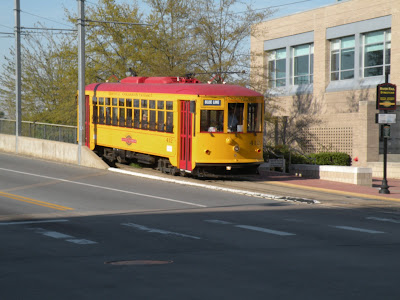skip to main |
skip to sidebar
Camden Expedition map at Steele's headquarters, Camden, Arkansas.
Prairie D'Ane (near Prescott), site of skirmishing and noisy "demonstrations," April 9-13, 1864.
Poison Springs, site of sharp engagement and massacre of African American troops (referenced in the movie Lincoln), April 18, 1864. Marker for First Kansas Colored Infantry Regiment.
Mark's Mills -- site of ambush and engagement, April 25, 1864. Jeremiah C. France (my great great grandfather Samuel France's younger brother), 43rd Indiana, fought here. His regiment was virtually destroyed and many African Americans massacred by Confederates in the wake of chaotic fighting. Somehow Jeremiah survived and made it back to the main Union army, only to die of disease in January, 1865. He's buried in Indianapolis.
Markers for unknown dead soldiers on the battleground, Union and Confederate. There is no marker yet for the unknown dead civilians who had come into Union lines to escape the Confederacy, killed by Confederate cavalrymen.
Jenkins Ferry -- site of the final battle of the Camden Expedition, April 30, 1864. Here, Steele's Union army escaped and eventually made it back to Little Rock, from whence they'd begun that March. What was left of the 43rd Indiana was consolidated into the "Casual Detachment." San Antonio Bill had two Wisconson ancestors here, including Frederick "Fritz" Vorpahl, 27th Wisconsin. Overall casualties here, about 1700. Also referenced in the movie Lincoln.
Today's Rune: Breakthrough.
Little Rock, Arkansas, USA. Last time I came to town, Bill Clinton had won the presidential election (first term) but was still at the Governor's Mansion -- January 1993. There'd been news vans and hubbub, but even then the city was easily navigable. Pictured here is the Capital Hotel (interior and exterior), built in 1872 (with an addition in 1887 and later restorations). Rallied with compadres from East Coast school days (Evan and San Antonio Bill) at the hotel bar after a general recon of the riverfront.

There's a lot of history in Little Rock, no question, and some clever cultural development. I have only this constructive criticism: downtown could use a concentration of housing, such as apartments and condos, to bring it to critical mass and frisson. Whatever it takes, make it happen! (And a secondary observation: some of the busiest street corners are a little too close to the roadways, so that cars come wooshing dangerously by in a fleeting second where pedestrians are most at risk of being clipped).

One of the nifty-fifty bridges over the Arkansas River. Can you see the submarine "crouching" on the far shore?
Blue Line streetcar. I love it!
Legacy Hotel & Suites -- second oldest such building in Little Rock today, after the Capital. Originally the Hotel Frederica (1913), it was enlarged in the 1930s-1940s and (as the "Sam Peck") in 1960. It became the Legacy about ten years ago.
Today's Rune: Journey.
Michelangelo Antonioni's first color film -- Il deserto rosso / Red Desert / El desierto rojo / Le désert rouge (1964), presents a stunning palette, splashing colors and light onto buildings, characters and ecosystems in gyroscopic motion. Wild, man, with strange surreal interludes. Fellini's Giulietta degli spiriti / Juliet of the Spirits (1965) takes a similarly wild and colorful plunge. Both films have other things in common, too. For instance, both have a primary woman protagonist -- Monica Vitti, Antonioni's paramour at the time, as Giuliana in Red Desert, and Giulietta Masina, Fellini's wife, as Giuletta in Juliet of the Spirits. Weird enough. Both characters are a bit "touched" -- by an angel, perhaps, but also by post traumatic stress, too. Both are married and somewhat estranged from their husbands. Both experience the world in otherworldly ways.
In Red Desert, we see a dizzying range of shapes and forms, some natural, some human-made. We see mists and steam and fumes and ships and shacks and puddles and pipes and even a robot ~ it's all in there, and it's all pretty strange when laid out sequence by sequence. The music is a bit "touched," as well. The imagery and sound effects remind me of William Blake, responding to the Industrial Revolution in the early 1800s:
And did the Countenance Divine,
Shine forth upon our clouded hills?
And was Jerusalem builded here,
Among these dark Satanic Mills?
Many of these patterns and shapes are beautiful, too, bringing to mind Charles Baudelaire's Les Fleurs du mal / The Flowers of Evil (1857).
In Red Desert, Antonioni seems to be saying, this is the way it is. Get used to it, or not. And really, what's remarkable is how contemporary this film looks fifty years later. The cooling towers, the electrical grids, the waste pools and toxic fields: all of it could be here and now -- and is.
Today's Rune: Harvest. P.S.: A fond farewell to Roger Ebert.
Now's a good time for a little something about the characters and actors in Walter Salles' 2012 movie version of Jack Kerouac's 1957 novel On the Road, set in the late 1940s in the US and Mexico.
To me, Garrett Hedlund as Dean Moriarty (Neal Cassady) is sort of like Val Kilmer playing Jim Morrison in Oliver Stone's The Doors (1991). Moriarty (which happens to be one of my family names back in the mists of time) is a sort of prototype for tens of thousands of Americans living in the early 21st century -- careless, reckless, chaotic and driven. One of the best details about him -- which is not the case with his spiritual descendents, I'm guessing, is his holding onto a copy of Marcel Proust's Swann's Way throughout most of the frenetic journeys depicted in On the Road. In Swann's Way (the first part of Proust's massive novel À la recherche du temps perdu / In Search of Lost Time), Swann's obsession with Odette is a powerful thread that ties everything together; in On the Road, obsession runs through Moriarty's psyche (obsessions with fast driving, drugs and sex -- seeking and escaping) and ties him in knots. Several other characters, men and women, are equally obsessed with Moriarty, who serves as a fast-moving Pied Piper for their scurrying activities. Dean Moriarty has some ambition to be a writer himself, so when he hands Swann's Way off, we get the idea that he's finished with that notion.
Kristen Stewart as Marylou has a damaged, mischievous Chloë Sevigny vibe. As for the other women characters, well, let's face it: Jack Kerouac's On the Road is a far cry from a feminist manifesto. Though Simone de Beauvoir's Le Deuxième Sexe / The Second Sex was published in 1949, this is not Sur la route in France, but rather North America, and second wave feminism was not yet manifest here. In any case, there are brief interludes that include Elisabeth Moss (Mad Men), Alice Braga, Kirsten Dunst, Amy Adams and Marie-Ginette Guay, among others.
Viggo Mortensen is a hoot as Old Bull Lee (William S. Burroughs) -- right on.
The hardest role is that of Sal Paradise (Jack Kerouac). Sam Riley does a superb job with it -- despite sometimes over-the-top corny vocal delivery (this is really how Kerouac wrote and spoke). Who is this guy, this actor? It finally hit me afterward -- my God, he's the British dude who played Joy Division vocalist Ian Curtis in Control (the 2007 film directed by Anton Corbijn)! Ian Curtis -- Mr. Gloom himself -- committed suicide while (or was it right after?) listening to Iggy Pop's The Idiot, while also watching Werner Herzog's Stroszek, the offbeat film that ends in the mountains of North Carolina with a Cherokee tribal deputy on the radio to a dispatcher: "We have a 10-80 out here, a truck on fire, we have a man on the lift. We are unable to find the switch to turn the lift off, can't stop the dancing chickens. Send an electrician, we're standing by." It's those damn dancing chickens again, from Chagall to Pop and Fellini . . . worth noting repeatedly because yes, Virginia, everything really does connect to every other thing, plus the effort to make these crazy connections manifest keeps the synapses lively and dementia at bay -- maybe. But back to Sam Riley in On the Road -- he gets an A for his performance.
Today's Rune: Protection.
Much to yak about when it comes to Walter Salles' On the Road (2012), the movie version of Jack Kerouac's On the Road (1957) as augmented by the raunchier, sadder "scroll" draft.
In the USA at this juncture in 2013, you have to pretty much take sail to find On the Road on the silver screen. I don't know what happened to distribution, but I do know this: the box office proceeds for On the Road are sixteen times more outside the US than inside it. I mean, I know On the Road doesn't have the widespread appeal of Operation Dumbo Drop or March of the Ten Penguins or whatnot, but come on, peoples -- American fiction writers and poets don't get no respect in their own country. Support your local sheriff!
Seriously, there may be prodigious amounts of marijuana, Benzedrine and alcohol in On the Road, as well as a lot of sexual talk and innuendo (no particularly graphic sex, or not much), but why not give it a whirl anyway? Because it really is worth seeing on the big screen -- a much more pleasant experience than seeing Paul Thomas Anderson's The Master (2012) -- even though Amy Adams is in both (and has a bigger role in The Master), even though both The Master and On the Road have a migrant worker section and even though The Master and On the Road are set in the relatively near past -- mostly in the wake of the Second World War, with a Korean War soon to come.
More about On the Road in the near future, I suspect, dig or no dig.
Today's Rune: Signals.
Double luck on Easter Sunday at the Dallas Museum of Art (DMA): not only was there an open parking space across the street, but once inside, the same ticket was good for both the Cindy Sherman and Marc Chagall exhibitions, one right after the other.
Chagall (1887-1985) artifacts on display include costumes he designed for a World War Two era ballet, sculptures, miscellaneous ceramic items and paintings. Groovy times.
I remember as a kid seeing stained glass windows by Chagall in a small chapel outside of Petersburg, Virginia at the edge of a Civil War battlefield -- or was that in a dream?
"Dance like hypnotized chickens . . . " (Iggy Pop, "Lust for Life," 1977). Ha!
Today's Rune: Fertility.
Got to check out the Cindy Sherman exhibition at the Dallas Museum of Art (DMA) -- fantastic. Photos large, gigantic and miniature, in black & white and in full garish color. Cindy Sherman -- like Tracey Ullman, eh? They're both in their fifties, come to think about it. Still absorbing how it's different to see in person vs. with eyes only, refracted. Notice how in this image she looks like a character in an Antonioni movie?
Today's Rune: Joy.












.jpg)
















